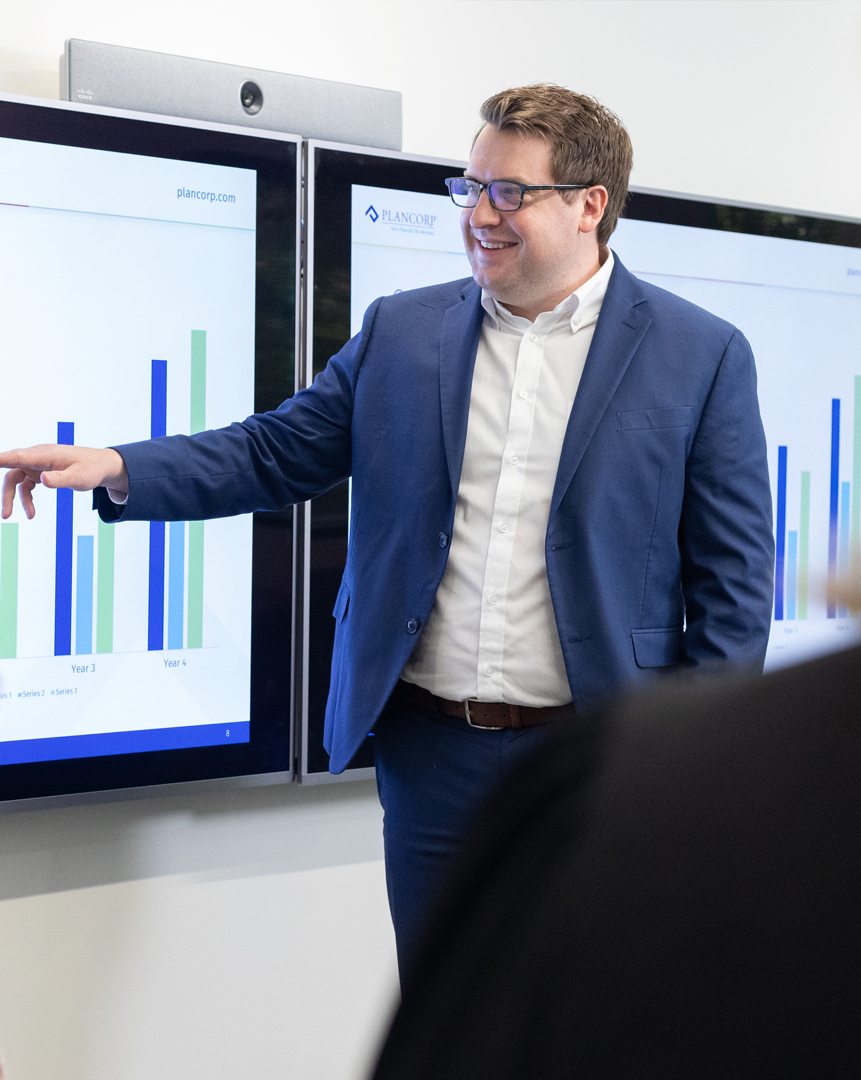Service Overview
Corporate Retirement Plan Advisors


Build a Retirement Plan That’s Right for You and Your Employees
Running your business and a 401(k) Plan can be stressful. When clients hire our team they know they can relax—their retirement plan is handled. We help our clients find opportunities to reduce fees, save more money and ensure their retirement plan is a valuable recruiting and retention tool.
Our team specializes in helping clients run great 401(k), 403(b) and Cash Balance Plans. We know unique companies require unique solutions. We’ll help you take your retirement plan to the next level.
Our Approach
Integrated Solutions. Successful Outcomes.
Not all retirement plans are created equally—nor should they be. Plancorp’s Retirement Plan Advisors are committed to creating a customized solution tailored to your business.
We partner with you from day one to help you meet your fiduciary responsibilities at every stage of the process.
Our advisors work with you to determine your primary needs and objectives, so we can help develop the best solution for you and your employees.
We have the experience and expertise necessary to help you manage the liability that comes with a corporate retirement plan and help you work toward successful outcomes.
Schedule a Consultation-

Assess Current Plan
Do you know much you pay for your current plan? Are there any testing issues? Are there opportunities to improve your plan from an employee’s perspective? We’ll work together to uncover gaps.
-

Design a Custom Plan
Our advisors will design a custom plan for your business. We will reduce the workload for your HR & Finance team, simplify your fees, and help ensure you have a process to meet your required fiduciary duties. And we will always look for ways to help business owners save more.
-

Execute
A plan is only as good as it’s execution. Our team is built to provide 1-on-1 service to help employees understand their retirement plan. Our process ensures we are always on the same page as our clients and their retirement plan is helping the business accomplish its’ goals.
Maximize Your Plan, Engage Your Team
- Transform Your Plan Design
- Mitigate Fiduciary Liability
- Ensure Competitive Fees
- Exercise a Disciplined Investment Strategy
- Engage Employees
Transform Your Plan Design
Your plan’s framework should ensure you can accomplish your goals, your business can accomplish its goals, and do it all without unexpected DOL testing failures.
A custom plan design can help you get there by:
- Helping you recruit and retain talented employees
- Allowing business owners and executives opportunities to save $70k+ into the 401(k)
- Eliminating 401(k) testing
Mitigate Fiduciary Liability
Running a 401(k) for your business comes with fiduciary responsibilities and risk. Our Fiduciary Plan Review helps mitigate that risk, while establishing a framework for managing duties.
Our fiduciary process:
- Complete documentation of trustee activities and employee education.
- An Investment Policy Statement (IPS) as a roadmap for investment oversight.
- Payroll integration assistance
- Annual process management guide for your HR and Finance teams
Ensure Competitive Fees
Plancorp’s team is experienced, independent and free from conflict. Our experts can evaluate your plan’s fees and compare them to your how they stack up against others in the industry.
- What are the costs of each of your service providers?
- Are your service providers compensated for recommending certain products? Are those in your best interest?
- What is the total cost of your plan? Is that reasonable for the services provided?
Exercise a Disciplined Investment Strategy
Our philosophy is anchored in evidence-based investing. We believe that a well-grounded, disciplined investment philosophy can reduce the angst of market volatility and help avoid fees that chip away at market performance.
- Does your current plan offer:
- Low-cost investments?
- A transparent fee structure?
- Broadly diversified investment options?
- Turn-key model portfolios at no additional cost?
Engage Employees
As an employer, it’s important that you equip your participants for success. Plancorp’s financial planning workshops gives employees valuable information for their whole financial lives.
We touch on topics such as:
- The value of trusts, Wills and Powers of Attorney
- How to ensure they are saving enough to replace their income at retirement.
- Tax credits and planning tips to utilize
- Understanding how the retirement plan complements their entire benefits package.
Plancorp adheres to high levels of data privacy and cybersecurity to keep your information safe. Learn more here.
DISCOVER WEALTH ALIGNMENT
The Plancorp Crafted Advantage
Without realizing it, most people are stuck in the shallows of basic financial advice. We see great financial planning like an iceberg, with most of the real story happening below the surface.
With a process perfected over 40 years to dive deep and align your wealth with your goals and values, we can craft your advantage.
I'm Ready to Learn More
Are you paying too much for your company's 401(k) plan?
Request a free appraisal today for a breakdown of your current fees and how you stack up against peers and competitors. No fine print, no obligation.
Frequently Asked Questions
There are numerous examples of employer-sponsored plans, such as 401(k)s, defined benefit pension plans, Roth 401(k)s, 403(b)s, Simplified Employee Pension Plans, and Savings Incentive Match Plan for Employees.
Plancorp’s team is experienced, independent, and free from conflict. That means we can present an unbiased, transparent opinion that’s focused solely on ensuring your success.
ERISA Section 3(38) Investment Manager is an investment advisor who assumes sole fiduciary liability for investment selection and investment monitoring.
There are four fees included in retirement plans, and we'll scrutinize each to ensure you’re competitive. They include investment fees, advisor fees, recordkeeper fees, and third party administrator fees.
Our evidence-based investing approach is built on decades of academic research. We believe that a well-grounded, disciplined investment philosophy can reduce the angst of market volatility and help avoid fees that chip away at market performance.
We are only compensated from the fees our clients pay us -- not from the products or services we recommend. This allows us to remain objective.
Our professional team can guide you on other important financial strategies like wealth management, philanthropy, and charitable giving, institutional asset management, exit strategy, and more. For more information, click here.
Cash balance plans are a type of defined benefit plan in which the company makes contributions on behalf of all participants.
What sets these plans apart is they offer much higher contribution limits than a 401(k)—especially for older participants, who can contribute more than $200,000 a year after age 55—and provide a guaranteed retirement benefit.
A participant’s contributions also grow tax-deferred at a set interest rate, typically 4% to 5%, rather than based on investment performance.
If you're curious if a cash balance plan is right for your business, review this helpful article.
At Plancorp, we look out for you. That's why we take important measures to protect your security. Here are a few quick facts about how we put your security first.
-
We do not have access to your account credentials. We don’t store credentials for your linked financial accounts, either.
-
Your data is encrypted at rest and in transit. Our portal requires the latest TLS (a type of digital protocol that keeps data safe) for authentication and encryption.
-
We leverage industry leading cloud platforms to keep your data and account information secure.
Your Team
Plancorp’s team of retirement plan advisors have decades of experience that have solidified their understanding of corporate retirement planning and the importance of plan design. Our advisors are patient, friendly, and committed to helping companies empower their employees when it comes to their retirement planning.
Featured Resources
We Are Thought Leaders
As a top financial advisory firm in St. Louis, we’ve been established in local circles and national news outlets as industry thought leaders. Browse our featured resources to learn more about our approach to corporate retirement plans.
Like What You're Reading?
Get Insights to Your Inbox. Unsubscribe Anytime.
Schedule a Call With a Wealth Manager to Get Started
Let Plancorp help so you can focus on making the most of your wealth
St. Louis, MO | Nashville, TN | Boca Raton, FL | Sarasota, FL | San Francisco, CA
Direct: 636-532-7824 | Toll Free: 888-220-1163 | info@plancorp.com
- Legal Notices
- Privacy Policy
- ADV Part 2A
- View Cefex Certificate
- Form CRS
- Press Room
- Cyber Security Policies
- © 2025 Plancorp, LLC.
© 2025 Plancorp, LLC. All Rights Reserved.












